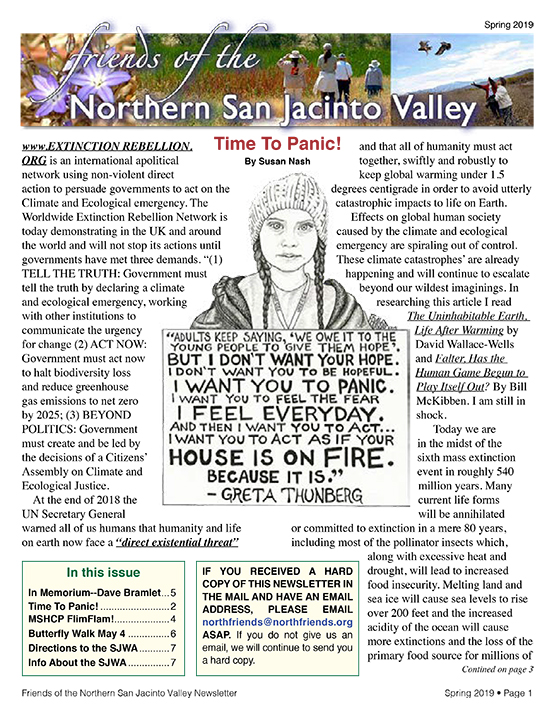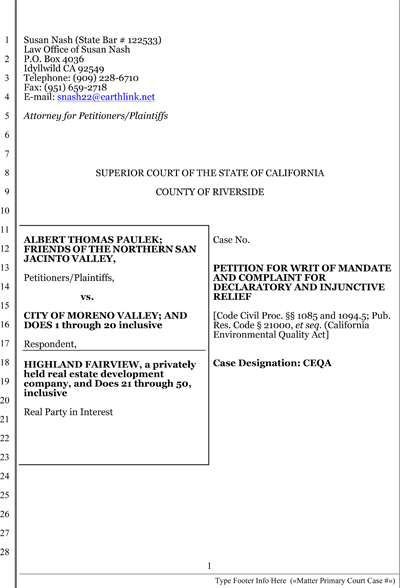How To Get Involved:
Go to the
Take Action page for information on how to get involved with the process of commenting on the
World Logistics Center; the
Mid-County Parkway and the
SR-79 Realignment.
Spring 2019 Newsletter
Click on image below to view and download the pdf.

Friends and numerous others have sued the City of Moreno over its approval of the World Logistics Center.
Click on image below to view and download the pdf.

An urgent letter sent to the Riverside County Board of Supervisors 8/20/12
Friends of the Northern San Jacinto Valley
P.O. Box 4266
Idyllwild CA 92549
www.northfriends.org
August 20, 2012
Riverside County Board of Supervisors
4080 Lemon Street
Riverside CA 92502
Re: Climate Change Impacts on Land Use Planning and the County General Plan
Dear Supervisors:
Several important studies have recently been issued which discuss the impacts on land use planning and the general plan in Riverside County. Those studies are attached. With the County general plan revision in progress, it is vitally important to the sustainability of Riverside County that this information be taken into account in determining the future of Riverside County.
The first of these is the 16-page summary “Our Changing Climate 2012, Vulnerability & Adaption to the Increasing Risks from Climate Change in California- A summary Report on the Third Assessment from the California Climate Change Center”, attached as “A”.
http://uc-ciee.org/climate-change/california-vulnerability-and-adaptation-study
This study makes the following points:
- Many of the gravest threats to public health in California stem from more frequent, more intense, and longer heat waves, multiple hot days in succession, heat waves occurring simultaneously in several regions throughout the state, air quality, food production, the amount and quality of water supplies, energy pricing and availability, and the spread of infectious diseases.
- The state’s urgent water management challenges posed by climate change include increasing demand from a growing population as temperatures rise, earlier snowmelt and runoff, and faster-than-historical sea-level rise threatening aging coastal water infrastructure and levees in the Sacrament-San Joaquin Delta.
- Increases in average temperature and higher frequency of extreme heat events combined with new residential development across the state will drive up the demand for cooling in summertime; however, electricity generation will be reduced substantially in the summer when hydropower generation is needed most to meet peak demand.
- If population and development were kept at today’s levels, a 100-year flood in 2100, after a 55 inch sea-level rise, would put at risk 480,000 people and $100 Billion of property (in 2000 dollars) along San Francisco Bay and the open coast. Sea level along the state’s coastline in 2050 could be 10-18 inches higher than in 2000, and 31-55 inches higher than in 2000, and 31-55 inches higher by the end of this century. Today’s 100-year storm could occur once every year. Sea level rise and associated coastal flooding are expected to put critical infrastructure at risk, including ports that support the economy and provide critical goods to the state and nation.
- Fires and Biodiversity
-
The most extreme increases in residential fire risks result from a combination of high-growth/high sprawl/ warmer-drier climate change scenarios, especially in San Francisco Bay and Southern California Counties.
- Several studies focus on how vegetation could shift with climate change and the capacity of species to migrate and keep up with geographic changes. Climate is changing conditions so rapidly that some vegetation cannot keep pace. Ecological impacts of climate change could be more severe than anticipated if species are unable to overcome physical barriers (such as human settlements) to migrate to areas with suitable climatic conditions. Desert climes could expand significantly, resulting in some species losing their habitats.
- The agricultural sector is already under stress from competing and growing urban and environmental water demands and continuing development on agricultural land. Indirect impacts could include possible further decreases of pollinators and increases of pests and disease. While many impacts on perennials vary by crop, nearly all annual crops are expected to decline under climate change.
- There are a number of adaption initiatives to date in the San Francisco Bay Area (Marin and Santa Clara Counties, the cities of San Francisco and Hayward, and the Bay Area-wide adaption effort under the Joint Policy Committee). Studies reveal how differences in social vulnerability make for inequality of impacts; such studies provide crucial information to local governments for determining where to focus limited resources for adaptive risk management. California has recognized the need to adapt to climate change impacts that can no longer be avoided. State, national and global efforts to mitigate climate change must be accelerated to limit global warming to levels that do not endanger basic life-support systems and human well-being, and to keep climate change within the bounds that allow ecosystems and society to adapt without major disruptions.
The second of these studies is Public Perception of Climate Change and the New Climate Dice” by James Hansen, Makiko Sato, and Reto Ruedy. Attached as B. http://arxiv.org/ftp/arxiv/papers/1204/1204.1286.pdf
The authors of this study conclude that extreme summers, such as those in Texas and Oklahoma in 2011 and Moscow in 2010, are a consequence of global warming, because global warming has greatly increased their likelihood of occurrence. Continued climate shift at the rate of the past three decades could take an enormous toll on planetary life. 21-52% of the species on Earth will be committed to extinction if global warming approaches 3 degrees C by the end of the century. We need to limit peak global warming to well under 2 degrees C if we are to preserve life on earth as we know it.
The third article is “Tomgram: Michael Klare, Post-Apocalyptic Fantasy Becomes Everyday Reality” by Michael Klare Attached as “C” http://www.tomdispatch.com/dialogs/print/?id=175579
Climate Change will cause rising temperatures, prolonged droughts, freakish storms, hellish wildfires, and rising sea levels. This will result in damaged infrastructure and diminished food supplies. These purely physical effects of climate change will, no doubt, prove catastrophic. But the social effects including food riots, mass starvation, state collapse, mass migrations, and conflicts of every sort, up to and including full-scale war, could prove even more disruptive and deadly. We can expect in the coming decades, rising temperatures, persistent droughts, recurring food shortages, and billions of famished, desperate people, millions of whom could be within our borders.
The fourth study we would like you to look at is the DVD, Climate Refuges by Michael P. Nash http://www.youtube.com/watch?v=kY5Er8hmAR8 and streamed on Netflix. Attached as “D”
The Pentagon now considers climate change a national security risk and the phrase “climate wars” is now being talked about in war rooms. The changing climate is already creating humanitarian disasters and will inevitability lead to worldwide political instability. Experts predict that by mid-century millions of people will be uprooted as a result of sea level rise and an increase in extreme weather events, droughts and desertification. Many millions of those refugees from around the world will be crossing our borders, legally or not.
We ask that you carefully consider the above, and more, when you make your decisions about the general plan, about “fast-tracking” and about the approval of each and every development in Riverside County for the rest of your terms in office. Friends will be making Catastrophic Climate Disruption and your response to it an issue in every way we can from specific project approvals to elections.
Thanks you for your consideration of this issue which is critical to civilization as we know it in Riverside County and around the Earth.
Susan Nash
President
909-228-6710
snash22@earthlink.net

